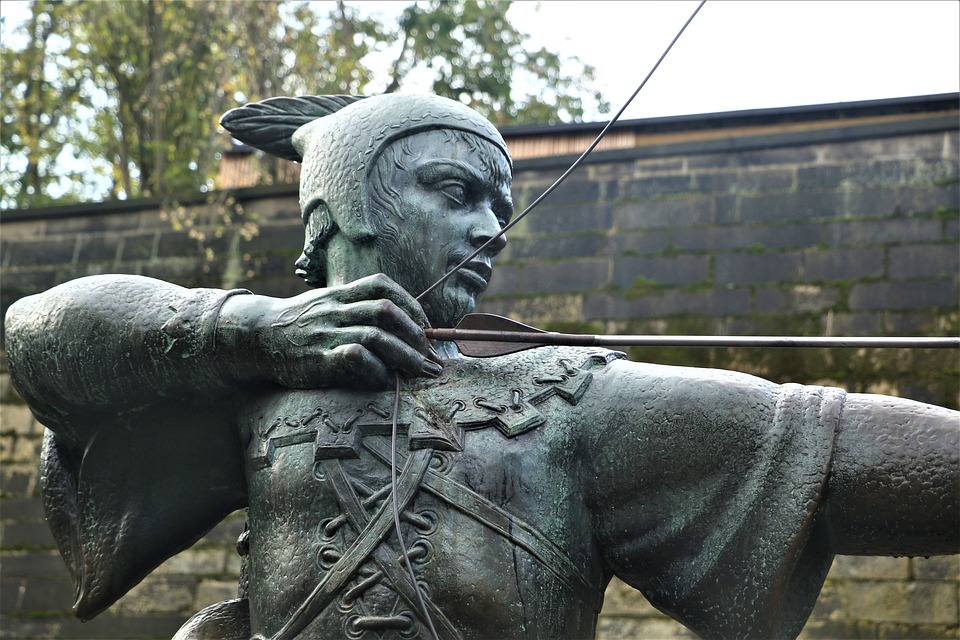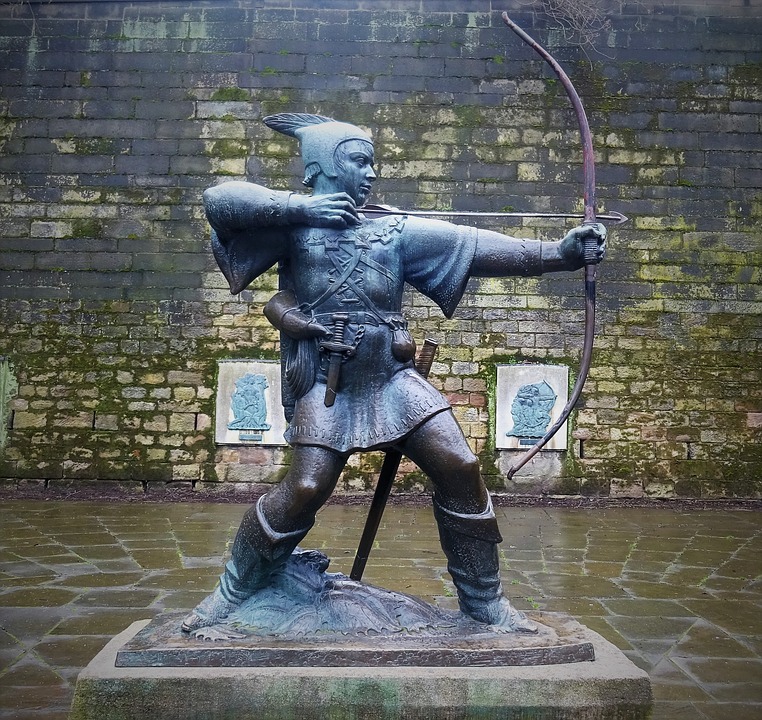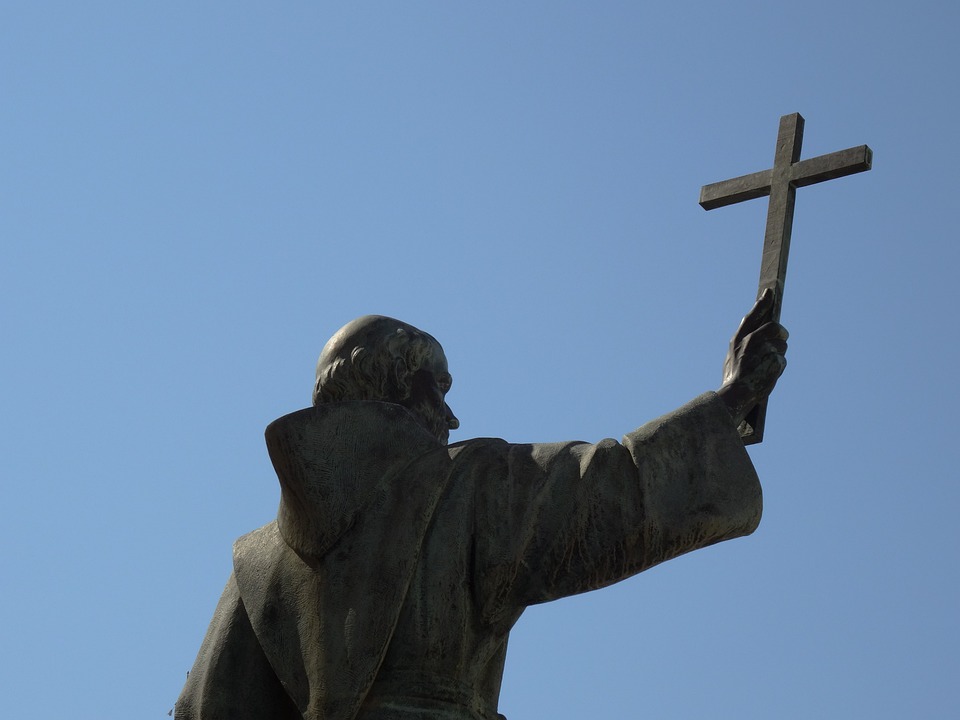Legend of Robin Hood

The legend of Robin Hood is an iconic, heroic outlaw from the Middle Ages in English folklore was one of England's best archer's and skilled swordsman of noble birth.
It is a story that blends legend with historical facts during the reigns of King Richard The Lionheart (1189 - 1199 AD) and his brother Prince John (1199 - 1216 AD) depicting Robin Hood and his Merry Men dressed in Lincoln green representing their unity with the forest and with each other as widely showcased in ballads, literature, film, cartoons, plays, musicals and television shows.
Robin Hood, having fought in the Crusades alongside King Richard the Lionheart (8 September 1157 – 6 April 1199), returned to England to find his lands seized by the Sheriff of Nottingham who assisted Prince John (24 December 1166 – to 19 October 1216) in usurping his brother, King Richard, to whom Robin Hood remained loyal.
Legend of Robin Hood portrays him as a popular folk hero through his generosity to the poor and down-trodden peasants during medieval England's oppressive economic and political, feudal system and the social relationships between lords and vassals who did not treat people equally.
Robin Hood justifies his robberies by stating that he takes money from the true thieves who prey on the poor.
Feudalism

Legend of Robin Hood
Feudalism began in England following the invasion and conquest of the country by William the Conqueror (1028 – 9 September 1087) which gave all ownership of the land to the King who then gave some to the barons.
The barons had to fight for the king and train his knights.
In return, the knights received some land from the barons.
The feudal tenant was entirely subject to the lord or manor to whom he paid dues and services in return for working and living off the land.

The Crusades

Legend of Robin Hood
The Crusades were religious military expeditions between 1095 and 1291 to recover the Holy Land from Islamic rule.
Richard the Lionheart was the Christian Commander of the Third Crusade between 1189 and 1192 after the departure of Philip II of France.
While he achieved victories against his Muslim counterpart, Saladin and finalized a peace treaty, he did not retake Jerusalem.
Sailing home via the Adriatic, he was captured and imprisoned in the castle of Duke Leopold of Austria, whom he had insulted during the Crusade.
He was later handed over to the German, Holy Roman Emperor, Henry VI who wanted a ransom of 35 tons of silver to release him.
The Dowager, Queen Eleanor and Hugh Walter, the Archbishop of Canterbury, raised the required ransom money to free Richard in 1194.
During its long history, Jerusalem has been attacked 52 times, captured and recaptured 44 times, besieged 23 times, and destroyed twice.

Legend of Robin Hood

The legend of Robin Hood evolved through medieval verses of poetic ballads and the pages of books that expressed the popular aspirations of a turbulent medieval era which ultimately culminated in the Peasants’ Revolt of 1381.
Robin Hood treated women, the poor and the humble as a philanthropist who robbed from the land owning feudal lords who collected oppressive taxes as well as the abbotts and other ecclesiastical landowners who lived and feasted like lords, so he could give to the poor.
As an outlaw, he and his faithful band of Merry Men lived in Sherwood Forest near the town of Nottingham, England.
Among his Merry Men included Little John, Much the Miller’s Son, Will Scarlet, Friar Tuck, Alan-a-Dale, and, of course, there was his sweetheart, Maid Marian.
Their two powerful enemies were the corrupt Sheriff of Nottingham and Prince John.
There have been many movies about Robin Hood, including the classic, 1938 "The Adventures of Robin Hood" starring Errol Flynn and Olivia de Havilland which is by far the best.
Sheriff of Nottingham
Legend of Robin Hood
The Sheriff of Nottingham is the archenemy in the legend of Robin Hood who subjects the local people to heavy taxes.
The 1066 invasion of England by William the Conqueror made Sherwood Forest a Royal Hunting Forest.
The sheriff was responsible for enforcing the forest laws that restricted hunting rights in all the Royal Forests (includin Sherwood Forest), capture outlaws like Robin Hood to ensure the safety of trade routes through the forest and to keep them from poaching the King's deer.
Robin Hood and his Merry Men however, enjoyed the forbidden hunting of Sherwood Forest and outwitted or killed corrupt forces which naturally appealed to the common people.
Robin Hood's Merry Men

Robin Hood's Merry Men were about 140 or 150.
Some ballads say there were 300 in the band.
Maid Marian
Marian is usually seen as a virtuous Norman aristocrat who was model of virtue and chastity.
She is Robin Hood's true love who is loyal, had courage and beauty.
Even, while cloistered away in Nottingham, she passed information to the Merry Men in Sherwood.
Robin Hood and Maid Marian marry after King Richard the Lionheart pardons all the outlaws of Sherwood Forest.
Little John
Little John was Robin Hood's most loyal friend, his chief lieutenant and second-in-command of the Merry Men.
He is one of the two oldest Merry Men, alongside Much the Miller's Son.
Although his name is 'Little John' he was in fact described as being very tall.
Will Scarlet
Will Scarlet is a prominent member of Robin Hood's Merry Men who is portrayed as the son of a noble.
He is a skilled fighter, swordsman and woodsman who is next in importance after Robin and Little John.
Will loves fine elegant clothes who often wears red.
Friar Tuck
Friars are servants of God who pledge their lives to poverty and to helping the poor.
The jovial Friar Tuck in the folklore of Robin Hood is a kind-hearted man of God who will also fight for what is right.
And, he loves his food and ale as much as his love of God.
Alan-a-Dale
Alan-a-Dale is the wandering minstrel who Robin Hood spotted cheerfully singing his way through the forest.
The next day the same young man was seen trudging through the greenwood in a forlorn state because the girl he has been courting for over seven years is being forcefully married to an old knight.
Robin Hood helps him rescue his sweetheart by stopping the bishop from proceeding with the ceremony and helping Alan get wed instead.
Following the wedding Alan and his bride flee back to Sherwood Forest with Robin and the Merry Men.
Much the Miller's Son
Much turned outlaw after being caught poaching - a crime punishable by death.
Robin Hood saves saves the young man who is grateful by joining the Merry Men.

Sherwood Forest

Legend of Robin Hood
People young and old flock to England’s Nottinghamshire region for a tour of the legendary Robin Hood's former hangouts.
Sherwood Forest around 350,000 tourists annually, many from other countries.
Each August the nature reserve hosts a week-long Robin Hood Festival recreating a medieval atmosphere and featuring the major characters from the legend of Robin Hood.
Major Oak
Sherwood Forest is home to the famous Major Oak, which according to popular folklore was Robin Hood's principal hideout.
The oak tree is between 800 and 1,000 years old and since the Victorian era its massive limbs have been partially supported by scaffolding.
In February 1998 a local company took cuttings from the Major Oak and began cultivating clones of the famous tree with the intention of sending saplings to be planted in major cities around the world.
The Major Oak was featured on the 2005 BBC TV programme Seven Natural Wonders as one of the natural wonders of the Midlands.

Ezine Articles Author Link
Click on the Link Below

Newsletter Opt-in-Form
The Keen Traveler
Your second block of text...
Recent Articles
-
The Power of Money
Mar 23, 25 03:53 AM
The power of money provides financial security, enables one to fulfill financial needs, improves the quality of life and gives peace of mind during unexpected financial emergencies. -
Simplicity tranquility and enlightenment
Mar 16, 25 06:01 AM
Simplicity tranquility and enlightenment empowers the individual to live lighter and to add value to life through meaningful goals. -
Faith History and Culture
Jan 02, 25 12:48 AM
Faith history and culture have impacted human history in all places and times.


